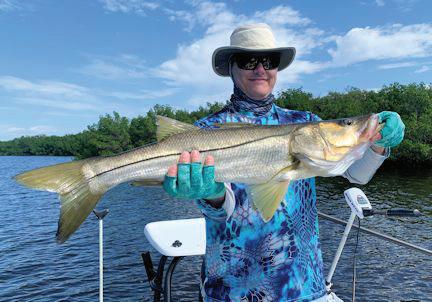
12 minute read
OUTDOORS
THE SUN OUTDOORS
Fall fishing frenzy
NOVEMBER 4, 2020
Reel Time
RUSTY CHINNIS
Shifting seasons bring welcome changes to the Gulf coast, especially those fall fronts that are the couriers of cooling temperatures and lower humidity. Local anglers, weary of the dog days of summer, welcome those changes. The arrival of massive bait schools in the passes and along the beaches are harbingers of the king mackerel, cobia, Spanish mackerel and little tunny that are never far behind.
While I love to fish for all these species, the little tunny (locally known as bonito) is my favorite to pursue. These members of the tuna family are notable for their stamina, long smoking runs and their ferocious feeding blitzes. Best of all, they attack top water patterns with a vengeance. Targeting














these rockets with fins is at once easy and frustrating. They can be easily found when they turn the water’s surface white in a feeding frenzy. Wheeling and diving terns and pelicans signal their general location
RUSTY CHINNIS | SUN

from miles away.
In the past, the method I used most often, once I found feeding fish, was what is referred to as the “run and gun.” The routine was to run on plane within casting distance


of feeding fish, cut the engine and fire a cast into the melee before they sounded. That method worked, provided the angler is ready and can get off a quick cast. Fumble with the line or make too many false casts and the fish are notorious for disappearing and then reappearing where you originally ran from. Bait schools are generally spread over a wide area and the schools of little tunny appear suddenly, ferociously attack one school and then just as quickly sound and pop up on another school nearby. If they “stay up” long enough the run and gun works, but they more often bounce quickly from one school to another.
Over the years I’ve found that the best strategy when the fish show only for a short time is to watch the birds, get in the area they are patrolling and let the fish come to you. I can’t emphasize enough the need to make a quick cast, which will vastly increase your odds of a strike and hookup. Another method I’ve used over the years to
SEE REEL TIME, PAGE 19

REEL TIME: Fall fishing frenzy
FROM PAGE 18 entice fish to the fly (this works great with Spanish mackerel) is to get in an area where there’s action and slap the fly on the water and rip it off repeatedly before making a presentation. The disturbance on the water attracts feeding fish and can be very effective on the edges of bait schools when fish aren’t showing on the surface.
Little tunny can be caught on fly and spinning tackle as well as live bait but I prefer to fish them on fly with top water patterns. I use an 8-weight outfit with a 10-12-foot tapered leader and a 30-pound fluorocarbon bite tippet. The fluorocarbon leader sinks, which may seem counterintuitive with a top water pattern, but that actually creates more surface disturbance with the gurgler and crease flies I like to use. Little tunny don’t have sharp teeth, but the 30-pound bite tippet provides some protection from Spanish mackerel which are often mixed in the feeding fish. Early or late in the day when the sun is low, and on cloudy days or in turbid water, 40-pound bite tippet will provide a more robust defense.
As I write this column a front has blown in with 20-plus mile an hour winds and cool temperatures. By the time you read this, conditions should be perfect. But don’t wait too long - when water temperatures cool significantly, these schools of fish will move south in pursuit of migrating baitfish.
Sea turtle season called success
Sea turtle nesting season ended Oct. 31 on Anna Maria Island with fewer nests and hatchlings than the record, but Anna Maria Island Turtle Watch and Shorebird Monitoring Director Suzi Fox considers it a success.
The not-for-profit organization overcame significant staffing reductions due to COVID-19 and the difficulties of relocating all the turtle nests out of the path of the ongoing beach renourishment project, which was in operation the last during four months of the six-month nesting season.
The 349 nests laid this season fell short of the 2019 nesting record of 544 nests. Of the nests laid, 289 hatched, producing 20,237 hatchlings, down from 2018’s record of 35,788 hatchlings.
With its challenges, the renourishment produced an unexpected benefit, Fox said. Black skimmers are flocking to the newly-renourished beach several months before shorebird nesting season. Prior to renourishment, the beach was too skinny, leaving little room for shorebirds to nest, she said, adding, “This beach is really being developed for the endangered species and the good of this Island.”
Fishing heats up as fall cools down
CAPTAIN RICK GRASSETT
Anglers fishing with me out of CB’s Saltwater Outfitters on Siesta Key had good action with snook on DOA Lures in Gasparilla Sound recently. Jon Yenari and Kyle Ruffing, both from Sarasota, caught and released numerous snook to 30 inches, trout and a red on CAL shad tails while fishing that area with me. Fly anglers also had some action with false albacore and tripletail in the coastal Gulf on another recent trip.
Fish the coastal Gulf for false albacore (little tunny), Spanish mackerel and tripletail when conditions are good. Shallow water action for reds and snook should turn on as the water cools. Fishing deep grass flats of Sarasota Bay is also a good choice for action with a variety of species including trout, blues and Spanish mackerel.
Our natural resources are under constant pressure from red tides
November is Manatee Awareness Month and the Florida Fish and Wildlife Conservation Commission (FWC) is reminding boaters that these large marine mammals are especially vulnerable to boat strikes this time of year.
As cold weather approaches, manatees begin to head towards warmer waters in Florida’s springs and near power plant outflows, causing them to spend more time in high-traffic boating areas.
The impact of boats on manatees prompted former Florida Gov. Bob Graham to establish November as Manatee Awareness Month in 1979.
To help protect the state’s official marine mammal, follow these tips: • Obey posted signs for manatee slow-speed zones.
CAPTAIN RICK GRASSETT | SUBMITTED Kyle Ruffing, from Sarasota, with a snook caught and released on a CAL Shad while fishing Gasparilla Sound with Capt. Rick Grassett recently.

fueled by industrial, agricultural and residential runoff, freezes, increasing fishing pressure and • Wear polarized sunglasses to see manatees in your path. • Keep a lookout for the circular “footprints” or ripples they leave on the surface of the water. • If you observe a manatee mating herd - several manatees gathering as males vie to mate with a female - watch from at least 100 feet away. Coming any closer might disrupt the mating or endanger you; adult manatees typically weigh more than 1,000 pounds. • Never feed or water manatees as they will become habituated to people, which could put them at risk of injury. • Stow trash and line when underway. Marine debris that blows overboard can become ingested by or entangled around manatees.
Contact the Florida Fish and Wildlife habitat loss and degradation - please limit your kill, don’t kill
Watch out for manatees on the move

your limit! Conservation Commission Wildlife Alert hotline at 1-888-404-FWCC (3922) or text Tip@MyFWC.com if: • you see a manatee with a pink or red (fresh) wound. • the manatee is tilting to one side, unable to submerge or seems to have trouble breathing. • you see a manatee calf by itself with no adults around for an extended period of time. • you see anyone harassing a manatee in any way. • you see boaters speeding in a protected area. • you see a manatee entangled in monofilament, crab-trap lines or other debris. • you see a dead manatee.

Mosquito alert issued
The Florida Department of Health in Manatee County advises residents that there has been an increase in mosquitoborne disease activity in areas of Manatee County.
A human case of West Nile Virus has been confirmed and there is a heightened concern additional residents will become ill.
Manatee County Mosquito Control and the health department reminds residents and visitors to avoid being bitten by mosquitoes and to take basic precautions to help limit exposure.
To protect yourself from mosquitoes, you should remember to “Drain and Cover:”
DRAIN standing water to stop mosquitoes from multiplying. • Drain water from garbage cans, house gutters, buckets, pool covers, coolers, toys, flowerpots or any other containers where sprinkler or rainwater has collected. • Discard old tires, drums, bottles, cans, pots and pans, broken appliances and other items that aren’t being used.
• Empty and clean birdbaths and pet water bowls at least once or twice a week. • Protect boats and vehicles from rain with tarps that don’t accumulate water. • Maintain swimming pools in good condition and appropriately chlorinated. Empty plastic swimming pools when not in use.
COVER skin with clothing or repellent. • Clothing - Wear shoes, socks, and long pants and long sleeves. This type of protection may be necessary for people who must work in areas where mosquitoes are present. • Repellent - Apply mosquito repellent to bare skin and clothing. • Always use repellents according to the label. Repellents with DEET, picaridin, oil of lemon eucalyptus, para-menthane-diol, 2-undecanone and IR3535 are effective.
• Use mosquito netting to protect children younger than 2 months old. • Doors and windows – use screens to keep mosquitoes out of your house. Repair broken screening on windows, doors, porches and patios.
TIPS ON REPELLENT USE • Always read label directions carefully for the approved usage before you apply a repellent. Some repellents are not suitable for children. • Products with concentrations of up to 30 percent DEET (N, N-diethyl-m-toluamide) are generally recommended. Other U.S. Environmental Protection Agencyapproved repellents contain picaridin, oil of lemon eucalyptus, para-menthane-diol, 2-undecanone or IR3535. These products are generally available at local pharmacies. Look for active ingredients to be listed on the product label. • Apply insect repellent to exposed skin, or onto clothing, but not under clothing.
• In protecting children, read label instructions to be sure the repellent is ageappropriate. According to the Centers for Disease Control and Prevention (CDC), mosquito repellents containing oil of lemon eucalyptus or para-menthane-diol should not be used on children under the age of 3 years. DEET is not recommended on children younger than 2 months old. • Avoid applying repellents to the hands of children. Adults should apply repellent first to their own hands and then transfer it to the child’s skin and clothing. • If additional protection is necessary, apply a permethrin repellent directly to your clothing. Again, always follow the manufacturer’s directions.
For more information on what repellent is right for you, consider using the Environmental Protection Agency’s search tool to help you choose skin-applied repellent products: http://cfpub.epa.gov/oppref/ insect/#searchform.
Water quality report
Bayfront Park North Bradenton Beach Coquina Beach North Coquina Beach South Manatee Beach North Palma Sola Bay South
Source: Florida Department of Heath


Good Good Good Good Good Good RED TIDE REPORT High Very low (respiratory irritation, shellfish harvesting (possible respiratory irritation) closures, fish kills, water discoloration) Background Medium (no effects) (probable respiratory irritation, shellfish harvesting closures, fish kills) None (no red tide present)Low (possible respiratory irritation, shellfish harvesting closures, fish kills) Source: Florida Fish and Wildlife Conservation Commission











PLAYERS: Returning - virtually
FROM PAGE 15 put on a performance from their homes. It also allows for the use of special effects and backgrounds that can help enhance the performance. Through special effects and dialogue, characters can be created for the performance that only exist just off the



screen, where they can be heard but not seen. Steiger also is serving as the composer for the production.
“I know one important element of this to me is to find some way to bring together this really vibrant community of folks who support the Island



Players and are a part of the Island Players,” he said. “This isn’t just a theatrical event, it’s letting ourselves know and letting other people know that the theater is continuing and that it will, as it has for all these years, survive and grow.”
“It’s a play that is ‘A Christmas Carol’ adapted for this time but also a production that I think is implicitly about the vibrant community of the Island Players,” Steiger said.
The curtain rises, virtually, on “A Christmas Carol” for two shows Dec. 18 and 20 at 7:30 p.m. For more information, visit the Island Players online at www. theislandplayers.org or call the box office at 941-778-5755.




